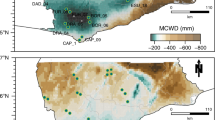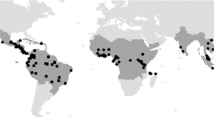Abstract
Studies of the variation in tropical plant species diversity and itsrelationship with environmental factors are largely based on research intropical moist/wet forests. Seasonally dry tropical forests (SDTFs), incontrast, have been poorly investigated. In this paper we present data from 20Mexican SDTF sites sampled to describe the magnitude of floristic diversity inthese forests and to address the following questions: (i) to what extent isspecies diversity related to rainfall? (ii) Are there other climatic variablesthat explain variation in species diversity in SDTFs? (iii) How does speciesidentity vary spatially (species turnover) within the country? We found thatspecies diversity was consistently greater (a ca. twofold difference) than wouldbe expected according to the sites' precipitation. Rainfall did notsignificantly explain the variation in species diversity. Likewise, the numberof dry and wet months per year was unrelated to species diversity. In contrast,a simple measure of potential evapotranspiration (Thornthwaite's index)significantly explained the variation in species diversity. In addition to thegreat diversity of species per site (local diversity), species turnover wasconsiderable: of a total of 917 sampled species, 72% were present only in asingle site and the average similarity (Sorensen's index) among sites wasonly 9%. These aspects of floristic diversity and the high deforestation ratesof these forests in Mexico indicate that conservation efforts should be directedto tropical forests growing in locations of low and seasonal rainfall.
Similar content being viewed by others
References
Alley W.M. 1984. The Palmer drought severity index: limitations and assumptions. Journal of Climate and Applied Meteorology 23: 1100–1109.
Arriaga L. and Leon J.L. 1989. The Mexican tropical deciduous forest of Baja California Sur: a floristic and structural approach. Vegetatio 84: 45–52.
Bullock S.H., Mooney H.A. and Medina E. (eds) 1995. Seasonally Dry Tropical Forests. Cambridge University Press, Cambridge, UK.
Clinebell R.R., Phillips O.L., Gentry A.H., Stark N. and Zuuring H. 1995. Prediction of neotropical tree and liana species richness from soil and climatic data. Biodiversity and Conservation 4: 56–90.
Connell J.H. and Orias E. 1964. The ecological regulation of species diversity. American Naturalist 98: 399–491.
Currie D.J. and Paquin V.I. 1987. Large scale biogeographical patterns of species richness of tree. Nature 329: 326–327.
Dirzo R. and Gomez G. 1996. Ritmos temporales de la investigacion taxonomica de plantas vasculares en Mexico y una estimacion del numero de especies conocidas. Annals of the Missouri Botanical Garden 83: 396–403.
Fisher A.G. 1960. Latitudinal variation in organic diversity. Evolution 14: 64–81.
Gentry A.H. 1982. Patterns of Neotropical plant species diversity. Evolutionary Biology 15: 1–54.
Gentry A.H. 1988. Changes in plant community diversity and floristic composition on environmental and geographical gradients. Annals of the Missouri Botanical Garden 75: 1–34.
Gentry A.H. 1991. The distribution and evolution of climbing plants. In: Putz C.E. and Mooney H.A. (eds), The Biology of Vines. Cambridge University Press, Cambridge, UK pp. 3–49.
Gentry A.H. 1995. Diversity and floristic composition of neotropical dry forests. In: Bullock S.H., Mooney H.A. and Medina E. (eds), Seasonally Dry Tropical Forests. Cambridge University Press, Cambridge, UK, pp. 146–194.
Gillespie T.W., Grijalva A. and Farris Ch.N. 2000. Diversity, composition, and structure of tropical dry forests in Central America. Plant Ecology 14: 37–47.
Heywood V.H. and Watson R.T. 1995. Global Biodiversity Assessment. United Nations Environment Programme, Cambridge University Press, Cambridge, UK.
Holdridge L. 1967. Life Zone Ecology. Tropical Science Center, San Jose, Costa Rica.
Hubbell S.P. 1979. Tree dispersion, abundance and diversity in tropical dry forest. Science 203: 1299–1309.
Huston M.A. 1994. Biological Diversity. The Coexistence of Species on Changing Landscapes. Cambridge University Press, Cambridge, UK.
Janzen D. 1988. Tropical dry forest. The most endangered major tropical ecosystems. In: Wilson E.O. (ed.), Biodiversity. National Academy Press, Washington, DC, pp. 130–137.
Kohlman B. and Sanchez-Colon S. 1984. Estudio aerografico del genero Bursera en Mexico. In: Ezcurra E., Equihua M., Colman B. and Sanchez-Colon S. (eds), Metodos cuantitativos en la Biogeograf?a. Instituto de Ecolog?a, Mexico.
Lott E.J., Bullock S.H. and Solis-Magallanes J.A. 1987. Floristic diversity and structure of upland and arroyo forests of coastal Jalisco. Biotropica 19: 228–235.
Lundell C.L. and Lundell A.A. 1983. The flora of northern Yucatan and Coba area of Quintana Roo, Mexico. Collections and observations in 1938. Wrightia 7: 97–228.
MacArthur R. 1965. Patterns of species diversity. Biological Review 210: 510–533.
Magurran A.E. 1988. Ecological Diversity and its Measurement. Princeton University Press, Princeton, New Jersey.
Miranda F. 1942. Estudios sobre la vegetacion de Mexico. III. Notas sobre la vegetacion del suroeste del estado de Puebla. Anales del Instituto de Biolog?a. UNAM Tomo XIII 2: 417–459.
Miranda F. 1947. Estudios sobre la vegetacion de Mexico.V. Rasgos de la vegetacion del R?o Balsas. Revista de la Sociedad Mexicana de Historia Natural 8: 95–114.
Miranda F. 1952. La vegetacion de Chiapas Vol. 1 and 2. Ed. Del Gobierno de Chiapas, Mexico.
Miranda F. and Hernandez-Xolocotzi E. 1963. Los Tipos de Vegetacion de Mexico y su Clasificacion. Bolet?n de la Sociedad Botanica de Mexico 28: 29–179.
Mittermeier R.A and Mittermeier C.G. 1992. La Importancia de la Diversidad Biologica de Mexico. In: Sarukhan J. and Dirzo R. (eds), Mexico Ante los Retos de la Biodiversidad. CONABIO, Mexico, pp. 63–74.
Mooney H.A., Bullock S.H. and Medina E. 1995. Introduccion. In: Bullock S.H., Mooney H.A. and Medina E. (eds), Seasonally Dry Tropical Forests. Cambridge University Press, Cambridge, UK, pp. 1–8.
Murphy P.G. and Lugo A.E. 1986. Ecology of tropical dry forest. Annual Review of Ecology and Systematics 17: 67–88.
Peet R.K. 1974. The measurement of species diversity. Annual Review of Ecology and Systematics 5: 285–307.
Pennington R.T., Prado D.A. and Pendry C. 2000. Neotropical seasonally dry forest and Pleistocene vegetation changes. Journal of Biogeography 27: 261–273.
Pianka E.R. 1966. Latitudinal gradients in species diversity: a review of concepts. American Naturalist 100: 33–46.
Puig H. 1976.Vegetation de la Huasteca, Mexique. Mission Archeologique et Etnologique Francaise au Mexique, Mexico.
Ratter J.A. and Dargie T.C.D. 1992. An analysis of the floristic composition of 26 cerrado areas in Brazil. Edinburgh Journal of Botany 49: 235–250.
Ratter J.A., Bridgewater S., Atkinson R. and Ribeiro J.F. 1996. Analysis of the floristic composition of the Brazilian cerrado vegetation. II. Comparison of the woody vegetation of vn 98 areas. Edinburgh Journal of Botany 53: 153–180.
Rzedowski J. 1978. Vegetacion de Mexico. Ed. Limusa, Mexico.
Rzedowski J. 1991a. Diversidad y or?genes de la flora fanerogamica de Mexico. Acta Botanica Mexicana 14: 3–21.
Rzedowski J. 1991b. El endemismo en la flora fanerogamica mexicana: una apreciacion anal?tica preliminar. Acta Botanica Mexicana 15: 47–64.
Rzedowski J. and Calderon G. 1987. El Bosque tropical caducifolio de la region mexicana del Baj?o. Trace 12: 12–21.
Sarukhan J. and Dirzo R. 2001. Biodiversity-rich countries. In: Levin S.A. (ed.), Encyclopedia of Biodiversity. Academic Press, San Diego, California, pp. 419–436.
SPP (Secretar?a de Programacion y Presupuesto) 1981. Atlas Nacional del Medio F?sico. SPP, Mexico.
Ter Steege H., Sabatier D., Castellanos H., Van Andel T., Duivenvoorden J., Adalardo de Oliveira A. et al. 2000. An analysis of the floristic composition and diversity of Amazonian forest including those of the Guiana Shield. Journal of Tropical Ecology 16: 801–828.
Thornthwaite C.W. 1948. An approach toward a rational classification of climate. Geographical Review 38: 55–96.
Toledo C. 1982. El genero Bursera (Burseraceae) en el estado de Guerrero (Mexico), Thesis, Facultad de Ciencias, UNAM, Mexico, DF.
Trejo I. 1996. Caracter?sticas del medio f?sico de la selva baja caducifolia en Mexico. Investigaciones Geograficas. Bolet?n Instituto de Geograf?a. Numero Especial 4: 95–110.
Trejo I. 1998. Distribucion y diversidad de selvas bajas de Mexico: relaciones con el clima y el suelo Ph.D. Thesis, Facultad de Ciencias, UNAM, Mexico, DF.
Trejo I. and Dirzo R.2000. Deforestation of seasonally dry tropical forest: a national and local analysis in Mexico. Biological Conservation 94: 133–142.
Valencia R., Balslev H. and Paz y Mino G. 1994. High tree alpha-diversity in Amazonian Ecuador. Biodiversity and Conservation 3: 21–28.
Villasenor J.L., Davila P. and Chiang F. 1990. Fitogeograf?a del Valle de Tehuacan-Cuicatlan. Bolet?n de la Sociedad Botanica de Mexico 50: 135–149.
Wilson E.O. 1988. Biodiversity. National Academy Press, Washington, DC.
Author information
Authors and Affiliations
Rights and permissions
About this article
Cite this article
Trejo, I., Dirzo, R. Floristic diversity of Mexican seasonally dry tropical forests. Biodiversity and Conservation 11, 2063–2084 (2002). https://doi.org/10.1023/A:1020876316013
Issue Date:
DOI: https://doi.org/10.1023/A:1020876316013




